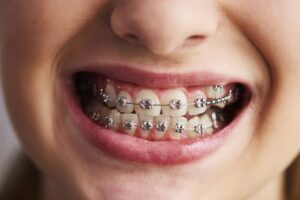
When Should You Take Your Child to an Orthodontist
According to the experts over at the American Association of Orthodontists (AAO), it's a pretty good idea to take your kiddo to see an orthodontist once they hit the age of seven. Now, you might wonder, "Why so early?" Well, this early peek into your child's chompers can be like a golden ticket to keeping their smile on the right track, and who wouldn't want that? Plus, it could save you from a headache and a half down the road with more complicated or pricey fixes.
Now, here’s where it gets fun! The AAO didn’t just write about it; they made a cool video to break it down for us. The video, called "When Should Your Child See an Orthodontist?", is part of their Straight Talk series. And guess what? It’s not just some boring lecture. Nope! Dr. Larry Wang, a real-deal orthodontist from the AAO, chats about why this age-seven check-up is a winner, and he’s joined by the Tooth Fairy and a super smart seventh-grader to jazz things up1. So, not only do you get the 411 from the pros, but there’s a dash of fairy dust and a slice of student smarts to keep things lively. Stick around, because we’ve got more tooth truths coming your way in this blog!
Age 7 - The Right Time to See an Orthodontist
At age 7, it's the perfect time for your child to visit an orthodontist. By this age, most children have a mix of baby and permanent teeth, allowing orthodontists to accurately assess their dental development. Here's why it's crucial to schedule that appointment:
Identify Potential Problems Early
By seeing an orthodontist at age 7, potential dental issues can be identified and treated before they worsen with growth. This early intervention can help prevent more complex problems in the future and potentially reduce overall treatment time.
Establish a Relationship and Foundation
Early visits to the orthodontist help establish a relationship between your child and the dental professional. This foundation sets the stage for ongoing care throughout their dental journey. It also allows the orthodontist to monitor your child's oral health as they grow.
Prevent Future Complications
Starting treatment at age 7 can address common issues such as crowding or bite problems. By intervening early, these problems can be corrected before they become more severe in adulthood. Addressing these concerns now can save your child from potential discomfort or complications later on.
Reduce Treatment Time
When orthodontic issues are detected early, treatment plans can be initiated promptly. This proactive approach may lead to shorter overall treatment times compared to waiting until adolescence or adulthood when certain conditions may become more difficult to correct.
Benefits of Early Orthodontic Evaluation and Treatment
Early orthodontic evaluation and treatment can provide numerous benefits for your child's oral health and overall well-being. Let's explore why it's important to consider early treatment.
Detecting Bite Problems, Overcrowding, and Jaw Misalignment
An early orthodontic evaluation, around the age of 7, helps identify bite problems, overcrowding of teeth, or jaw misalignment. By catching these issues at an early stage, orthodontists can develop a customized treatment plan to address them effectively.
Guiding Proper Tooth Eruption and Improving Facial Symmetry
Timely intervention allows orthodontists to guide the proper eruption of permanent teeth. By identifying potential issues with tooth alignment or spacing, they can take proactive steps to ensure that new teeth come in correctly. This not only improves dental function but also enhances facial symmetry.
Shortening Overall Treatment Time in the Future
Early orthodontic treatment may lead to shorter overall treatment time in the future. By addressing any existing problems promptly, orthodontists can prevent them from worsening over time. This reduces the complexity of future treatments and minimizes the need for extensive procedures later on.
Enhancing Oral Health and Boosting Self-Esteem
Correcting dental issues early on contributes to better oral health outcomes. When teeth are properly aligned and spaced, it becomes easier to maintain good oral hygiene practices such as brushing and flossing. Addressing aesthetic concerns through early orthodontic treatment can boost your child's self-esteem by giving them a confident smile.
Common Orthodontic Issues Addressed in Early Treatment
Orthodontic issues can arise at any age, but it's important to address them early on to ensure proper dental development and a healthy smile. Here are some common concerns that orthodontists can address during early treatment:
Crossbites
Crossbites occur when the upper teeth sit inside the lower teeth instead of outside. This misalignment can lead to jaw problems and uneven wear on the teeth. Early treatment can help correct crossbites and promote proper alignment.
Underbites
Underbites happen when the lower jaw protrudes forward, causing the lower front teeth to overlap the upper front teeth. This issue can affect speech, chewing, and facial appearance. Early orthodontic intervention can help correct underbites and improve overall oral health.
Overbites
Overbites occur when the upper front teeth significantly overlap the lower front teeth. This condition may cause difficulty in biting, speech problems, or an imbalanced facial profile. Early treatment can prevent further complications and guide proper tooth alignment.
Open Bites
Open bites result in a gap between the upper and lower front teeth even when the mouth is closed. It can impact eating, speech clarity, and facial aesthetics. Addressing open bites early on allows for effective correction.
In addition to these specific issues, early orthodontic evaluation also helps identify other problems such as crowded or crooked teeth, spacing issues, thumb sucking habits or tongue thrusting issues that may affect dental development.
By addressing these orthodontic concerns at an early age (around 7 years old), parents can ensure their child receives timely intervention to prevent more severe complications later in life.
Evaluating Your Child's Readiness for Orthodontic Treatment
When should your child see an orthodontist? Age 7 is a good time to start considering an evaluation. During this stage, an experienced orthodontist will assess your child's dental development and determine if orthodontic care is necessary.
Orthodontic evaluations involve various assessments to understand your child's oral health and needs fully. These evaluations may include X-rays, photographs, impressions, and a comprehensive examination. The orthodontist will closely examine factors such as tooth eruption, bone growth pattern, facial aesthetics, and oral habits.
The main goal of the evaluation is to identify any potential issues that could affect your child's oral health in the long run. By evaluating their dental development early on, the orthodontist can determine if intervention or treatment is needed.
Here are some key points to consider during the evaluation:
- Tooth Eruption: The orthodontist will assess the eruption of permanent teeth and evaluate how they align with the baby teeth.
- Bone Growth Pattern: Evaluating jaw growth patterns helps determine if there are any abnormalities or discrepancies that may require correction.
- Facial Aesthetics: The orthodontist will consider how your child's facial features align with their teeth and jaws to ensure a harmonious appearance.
- Oral Habits: Habits like thumb-sucking or tongue-thrusting can impact tooth alignment and jaw development. The orthodontist will evaluate these habits during the examination.
Based on the evaluation results, the orthodontist will recommend appropriate treatment options tailored to your child's specific needs. This may include braces or other appliances like a palatal expander.
Remember that every child is unique, so their readiness for orthodontic treatment depends on individual circumstances. Early evaluations allow for timely intervention when necessary, leading to better outcomes and a healthy smile.
The Process of a Child's Orthodontic Consultation
During your child's orthodontic consultation, the orthodontist will go over their medical history and address any concerns you may have. They'll conduct a thorough examination of your child's teeth, jaws, bite alignment, and oral habits to assess their dental health. This evaluation helps the orthodontist determine if any treatment is necessary.
In order to gather additional information about your child's dental development and growth, the orthodontist may use X-rays and other diagnostic tools. These aids provide a more comprehensive understanding of your child's oral condition.
Once the examination is complete, the orthodontist will explain their findings to you in detail. They'll discuss potential treatment options based on your child's specific needs. This is an opportunity for you to ask questions or voice any concerns you may have regarding the recommended course of action.
The consultation serves as an important step in determining when it is appropriate for your child to begin orthodontic treatment. By assessing factors such as thumb sucking habits, jaw alignment, and tooth positioning during this visit, the orthodontist can develop a tailored plan for your child's dental care.
Remember that each child is unique and may require different approaches. Consulting with an experienced orthodontist allows you to gain insight into your child's individual needs and explore suitable treatment options.
Signs Indicating the Need for Early Orthodontic Intervention
Congratulations on completing the sections before the conclusion! By now, you have gained valuable insights into why it is important to consider early orthodontic intervention for your child. Remember, at around age 7, it's a great time to schedule an appointment with an orthodontist. This early evaluation can help identify any potential issues and determine if treatment is necessary.
Now that you understand the benefits of early orthodontic evaluation and have learned about common orthodontic issues addressed in early treatment, take the next step and evaluate your child's readiness for orthodontic treatment. During a child's orthodontic consultation, their oral health will be thoroughly assessed, and a personalized treatment plan will be developed based on their specific needs.
Don't wait until it's too late! Take action now and schedule an appointment with an orthodontist to ensure your child's smile develops beautifully. Investing in their dental health at an early age can save them from potential complications later on.
Bruno Orthodontics offers Invisalign, braces, and other orthodontic treatment for adults, teens, and children in an award-winning office in Chevy Chase. Dr. Jill Bruno is a Diamond+ Provider for Invisalign, putting her in the top 1% of Invisalign doctors. Convenient online scheduling and virtual consults are available for new and current patients.




